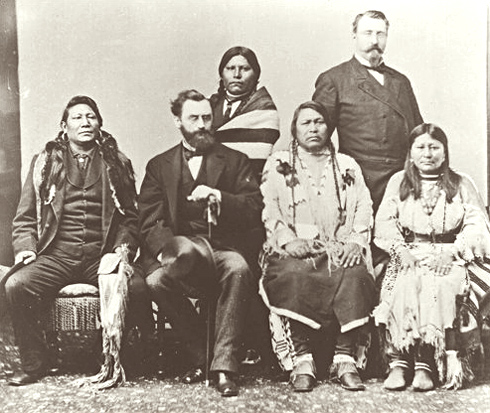Chief Ignacio on:
[Wikipedia]
[Google]
[Amazon]
 Chief Ignacio (1828–1913) was a chief of the Weeminuche band of the
Chief Ignacio (1828–1913) was a chief of the Weeminuche band of the  In 1887 the US Congress passed the
In 1887 the US Congress passed the
, Mountain Studies Institute, accessed 21 Dec 2010 Refusing to have their land broken up, Chief Ignacio and the Weeminuche people moved to the western part of the Southern Ute Reservation in 1896. Their descendants have occupied the
Find a Grave (memorial site)
1828 births 1913 deaths 19th-century Native Americans Native American history of Colorado Native American leaders Ute people 20th-century Native Americans {{NorthAm-native-bio-stub
 Chief Ignacio (1828–1913) was a chief of the Weeminuche band of the
Chief Ignacio (1828–1913) was a chief of the Weeminuche band of the Ute tribe
Ute () are the Indigenous people of the Ute tribe and culture among the Indigenous peoples of the Great Basin. They had lived in sovereignty in the regions of present-day Utah and Colorado in the Southwestern United States for many centuries unt ...
of American Indians, also called the Southern Utes, located in present-day Colorado north of the San Juan River.
He led the band through many difficult years in the late nineteenth century, when they were being encroached on by European-American settlers. In January 1880, Chief Ignacio was part of the Ute delegation that traveled to Washington, DC to testify before the US Congress about the 1879 Meeker Massacre
Meeker Massacre, or Meeker Incident, White River War, Ute War, or the Ute Campaign), took place on September 29, 1879 in Colorado. Members of a band of Ute Indians ( Native Americans) attacked the Indian agency on their reservation, killing the ...
and the Ute uprising among the northern Utes on the White River. Although the Weeminuche had not participated in that violence, white settlers wanted to push all the Utes away from their areas. The Utes tried to negotiate for peace, but later that year Congress passed legislation forcing the Utes into reservations. Unlike the Northern and Central bands of Utes, who were forced to reservations in Utah, the Weeminuche and two other Southern bands managed to stay in Colorado.
Together with the Muache and Capote Utes, the Weeminuche occupied the Southern Ute Indian Reservation
The Southern Ute Indian Reservation (Ute dialect: Kapuuta-wa Moghwachi Núuchi-u) is a Native American reservation in southwestern Colorado near the northern New Mexico state line. Its territory consists of land from three counties; in descendin ...
in southern Colorado and named their capital Ignacio
Ignacio is a male Spanish and Galician name originating either from the Roman family name Egnatius, meaning born from the fire, of Etruscan origin, or from the Latin name "Ignatius" from the word "Ignis" meaning "fire". This was the name of sev ...
in the chief's honor.
 In 1887 the US Congress passed the
In 1887 the US Congress passed the General Allotment Act
The Dawes Act of 1887 (also known as the General Allotment Act or the Dawes Severalty Act of 1887) regulated land rights on tribal territories within the United States. Named after Senator Henry L. Dawes of Massachusetts, it authorized the Pre ...
, better known as the Dawes Act
The Dawes Act of 1887 (also known as the General Allotment Act or the Dawes Severalty Act of 1887) regulated land rights on tribal territories within the United States. Named after Senator Henry L. Dawes of Massachusetts, it authorized the Pre ...
. It was intended to regulate the breakup of the communal Native American lands and assign separate householder allotments of 160 acres each, with "surplus" land to be sold on the open market. This was another step in assimilating the Native Americans to European-American ways, based on individual landholdings. In 1895 the Southern Utes voted on the issue, narrowly passing a measure for allotment."Ignacio and the Southern Utes Tribe", Mountain Studies Institute, accessed 21 Dec 2010 Refusing to have their land broken up, Chief Ignacio and the Weeminuche people moved to the western part of the Southern Ute Reservation in 1896. Their descendants have occupied the
Ute Mountain Ute Reservation
The Ute Mountain Ute Tribe (Ute dialect: Wʉgama Núuchi) is one of three federally recognized tribes of the Ute Nation, and are mostly descendants of the historic Weeminuche Band who moved to the Southern Ute reservation in 1897. Their reservati ...
with headquarters at Navajo Springs. Later they moved their capital to Towaoc. The Ute Mountain Ute
The Ute Mountain Ute Tribe (Ute dialect: Wʉgama Núuchi) is one of three federally recognized tribes of the Ute Nation, and are mostly descendants of the historic Weeminuche Band who moved to the Southern Ute reservation in 1897. Their reservati ...
are one of three federally recognized tribes of the Ute people.
References
*External links
Find a Grave (memorial site)
1828 births 1913 deaths 19th-century Native Americans Native American history of Colorado Native American leaders Ute people 20th-century Native Americans {{NorthAm-native-bio-stub